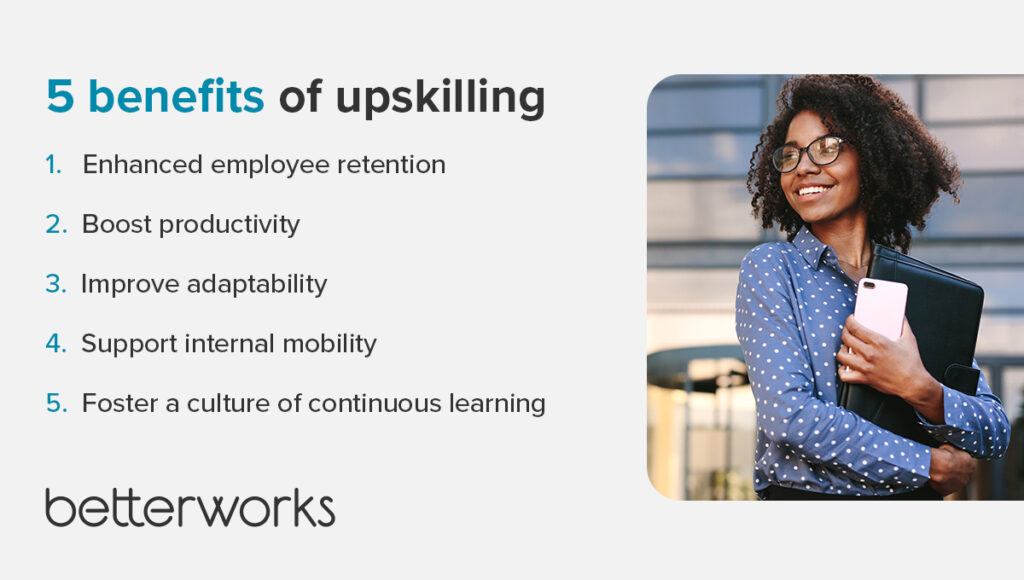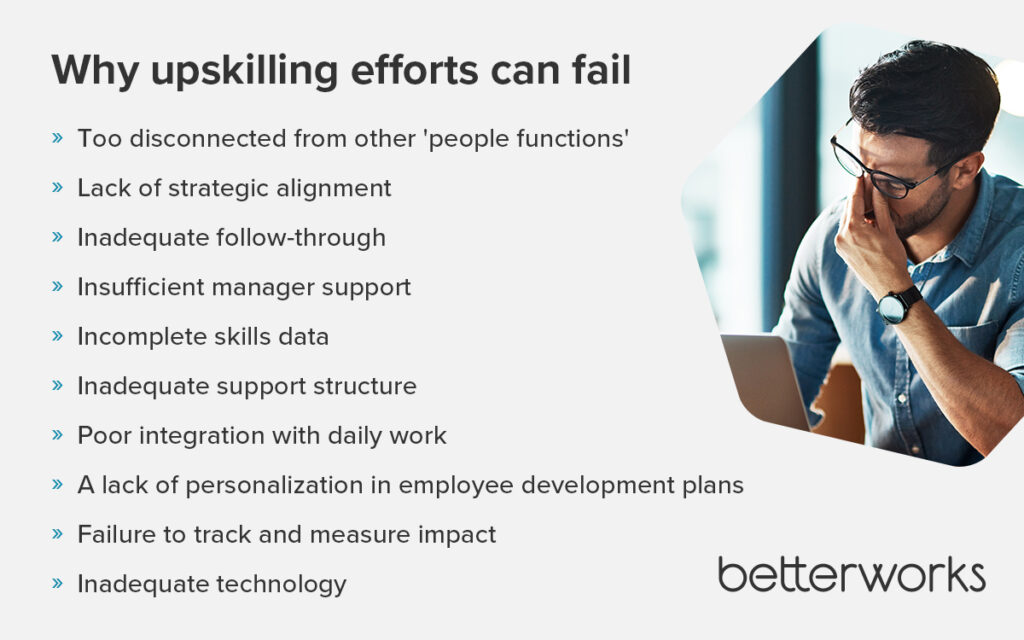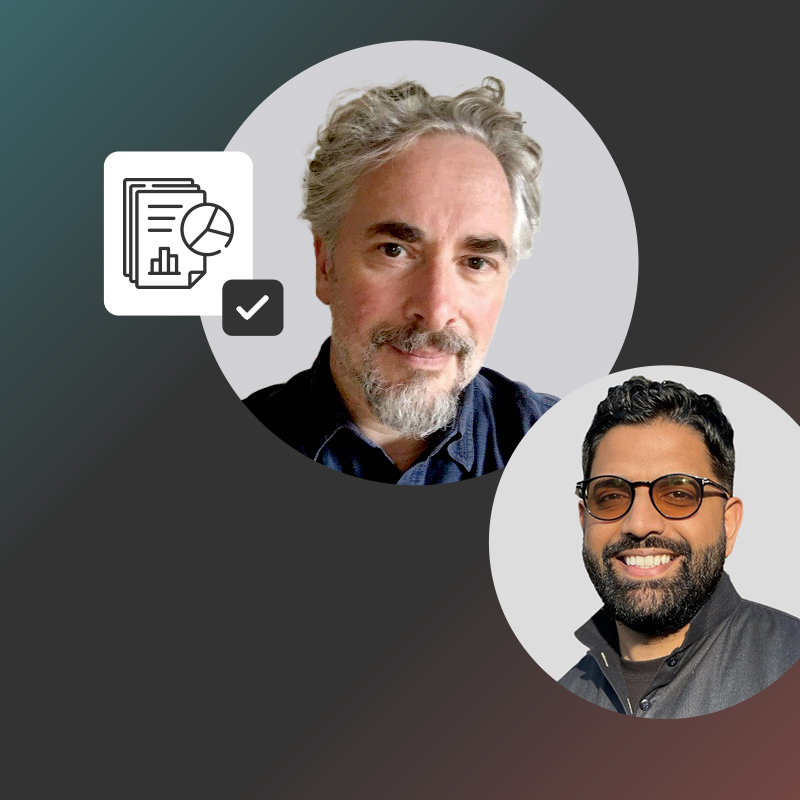The skills that got your workforce here won’t be enough to take them into the future.
Merely hiring new talent isn’t a sustainable solution, either.
Nearly 8 in 10 organizations have had to adjust job requirements or lower hiring standards due to a lack of qualified candidates, our 2024 Skills Fitness report found.
The sustainable solution lies in upskilling—strategically enhancing the skills of your current workforce to meet the future head-on. However, as these talent shortages grow more pronounced, traditional approaches to employee development won’t help close those gaps.
Learn how we’re evolving the definition of upskilling, why these programs so often struggled to achieve their goals in the past, and how to implement an effective upskilling strategy that aligns with your organization’s long-term goals.
What is upskilling?
Upskilling is the process of enhancing an employee’s current skills to meet the demands of evolving job roles. It focuses on both technical and soft skills, preparing employees to handle future challenges while ensuring their ongoing effectiveness in current roles. By aligning skill development with organizational goals, upskilling helps bridge skills gaps and build a sustainable talent pipeline that supports long-term business success.
In contrast, reskilling involves training employees for entirely new roles within the organization. Both reskilling and upskilling are essential strategies for adapting to a fast-changing job landscape, ensuring that your workforce remains flexible and capable of meeting business objectives.
One critical tool in modern upskilling programs: the talent profile. Unlike static performance reviews, a talent profile is a dynamic record of an employee’s work experience, skills, and growth goals. These profiles provide real-time insights into employee capabilities, giving HR leaders a broader, strategic view of their internal talent pool. This data is invaluable for identifying skills gaps and planning for future workforce needs.
By regularly updating talent profiles with data from performance reviews, learning management systems, and employee feedback, HR leaders can track skill development over time and address gaps more effectively. Aggregating this data at the team or organizational level offers a macro view of strengths and weaknesses, enabling targeted upskilling and reskilling efforts to ensure your workforce stays competitive in an evolving market.
5 benefits of robust upskilling programs
The benefits of upskilling go beyond just improving the skills of your employees. Upskilling also helps your organization by providing the following key benefits.
Enhanced employee retention
Upskilling provides employees with a clear career path, increasing job satisfaction and reducing turnover. By investing in their development, you strengthen your employer brand and improve retention rates.
Boost productivity
Employees with enhanced skills can contribute more effectively to your organization. This increased competency leads to improved performance, as employees become adept at tackling more complex tasks and using new technologies to streamline workflows.
Improve adaptability
Upskilling fosters a workforce that is agile and responsive to changes in the market. Employees are equipped to adapt quickly to new trends, technologies, and challenges, minimizing disruption.
Support internal mobility
Upskilling helps you identify talent within your organization, reducing the need for external hires. By promoting from within, you can fill key roles faster and improve employee morale by supporting their career development.
Foster a culture of continuous learning
Creating an upskilling strategy encourages a culture of continuous learning. Employees who see that learning and growth are valued will take the initiative in their own development, driving innovation and growth throughout the organization.

Why upskilling programs often struggle to succeed
Despite the clear benefits, upskilling programs often struggle to deliver the desired results. Understanding these common barriers can help you design more effective upskilling strategies that truly empower employees and drive organizational growth.
Too disconnected from other ‘people functions’
Upskilling should be integrated with performance management, career development, and succession planning. This creates a learning environment where employees can clearly see how their new skills fit into their career paths.
Lack of strategic alignment
Upskilling initiatives often fall short when not aligned with the organization’s overall goals. Ensure employees understand how their new skills contribute to business success to drive engagement and performance.
Inadequate follow-through
Upskilling doesn’t stop after training. Ongoing feedback and opportunities to apply new skills are critical for success. Regular check-ins and coaching are essential to keeping employees engaged and ensuring their development makes a real impact.
Insufficient manager support
Managers play a crucial role in upskilling efforts. Without the tools and resources to coach their teams, employees may lose interest in development programs. Equip managers to provide ongoing support and guidance to drive engagement.
Incomplete skills data
Having incomplete or outdated skills data can seriously hurt the effectiveness of upskilling programs. Many organizations rely on old performance reviews or employee self-assessments, which don’t always provide a clear picture of what skills employees actually have. While 69% of companies use performance data to assess skills, 56% only gather this information once or twice a year, which can lead to outdated or inaccurate insights, our research found.
Additionally, 65% of companies rely on department heads for skills assessments, but infrequent evaluations often provide flawed data. Prioritize collecting real-time, accurate skills data to make sure upskilling is targeted in the right areas.
Inadequate support structure
For upskilling programs to succeed, employees need more than just access to training—they need ongoing support in the form of mentorship, coaching, and feedback. However, 44% of employees report that they lack access to the mentorship and coaching they need to effectively apply their new skills, according to our 2024 Skills Fitness report.
Other shortcomings include poor integration of upskilling with daily work, a lack of personalization when it comes to employee skill-building plans, a failure to track and measure the impact of an upskilling program, and inadequate technology.

Upskilling examples: Practical approaches to skill development
Implementing an effective upskilling strategy requires more than just intention: it needs practical execution. Fortunately, there are several proven upskilling examples that can help your organization boost its talent development efforts.
- Online courses: These are among the most flexible and accessible upskilling opportunities, allowing employees to learn at their own pace. From technical certifications to soft skills training, online platforms cater to diverse needs.
- On-the-job training: Real-world learning experiences, such as mentoring, cross-training, and stretch assignments, give employees the chance to apply new skills in practical settings.
- Formal education: Partnering with universities or professional institutions to offer relevant courses can provide employees with advanced skills and a deeper understanding of their fields.
- Academies: A structured training program typically developed by an organization that helps employees — and in some cases partners and customers — learn new skills and knowledge. The goal: enable an organization to achieve its business goals and values by developing the skills of its employees.
Each of these upskilling opportunities supports continuous professional development and helps employees meet both their personal and career goals.
Linking L&D with performance management
Betterworks integrates learning and development (L&D) with performance management to help organizations create a culture of continuous growth. Rather than offering one-off training, employees are continuously developing new skills that align with business objectives and future needs.
Building skills into performance management programs creates structured pathways for employees to advance their careers while contributing to organizational success. Managers can set specific learning goals for their team members, track progress, and promote development efforts that align with broader business objectives. Address employee skills gaps with personalized skill development plans developed by the employee and their manager and based on rich data extracted from the performance management system. These plans should align with the company’s strategic business goals.
This connection between learning and performance is key to fostering agility and adaptability in the workforce. Employees are more engaged when they see how new skills directly impact their performance and career growth, allowing your business to stay competitive in a rapidly changing market. Betterworks’ integration of talent profiles, L&D, and performance data ensures that employees grow in alignment with organizational goals, addressing current skill gaps and preparing for future challenges.
Want to learn more? Discover how to use performance data to power a skills-based organization.
How do you rank as a skills-based organization?








